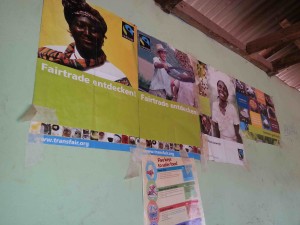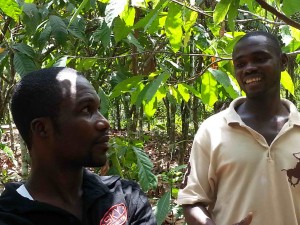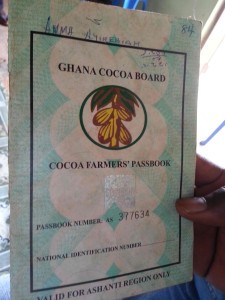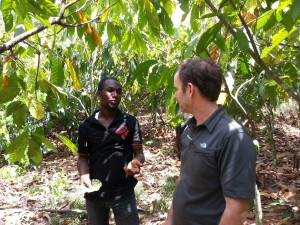
An important focus of the CGIAR Research Program on Forests, Trees and Agroforestry (FTA) lies on governance, trade and investment in value chains and the effects on smallholders and small-scale rural businesses. A value chain of particular importance to FTA is cocoa, both for its economic implications (roughly US$100 billion annual sales) and relevance for rural livelihoods (about 60 million people derive a significant part of their income from cocoa).
As global chocolate manufacturers increase their commitments to achieve a sustainable cocoa sector in the near future, there is a growing need for third-party evidence of progress towards this goal. Voluntary standards systems, such as Fairtrade, provide such independent testimony, but they themselves require science-based evidence of their contributions to enhanced sustainability.
FTA researchers at World Agroforestry Centre (ICRAF) and Bioversity International have examined the contribution of Fairtrade to support cocoa smallholders in their pursuit of sustainable livelihoods and cocoa cooperatives to develop into viable businesses. This blog presents first findings emerging from a baseline study in Ghana that lays the foundation for assessing the impacts of Fairtrade on cocoa growers and their cooperatives.
Ghana, the world’s second largest cocoa producer, has ratcheted up its contribution of Fairtrade certified cocoa to world supplies within 5 years: production rose from just below 500 tons in 2009 to 54,600 tons in 2014. Around 6.1 percent of the total cocoa production in Ghana now runs under the label Fairtrade (up from less than one percent five years ago). Roughly 5,000 farmers are organized in Fairtrade-certified cocoa cooperatives.
 “From a global perspective the numbers look even more impressive,” says Dietmar Stoian, Principal Scientist at Bioversity International and one of the FTA researchers involved. “In 2014, Ghana contributed 38 percent to global sales of cocoa under Fairtrade terms.”
“From a global perspective the numbers look even more impressive,” says Dietmar Stoian, Principal Scientist at Bioversity International and one of the FTA researchers involved. “In 2014, Ghana contributed 38 percent to global sales of cocoa under Fairtrade terms.”
“Definitions of sustainable cocoa vary though,” knows Divine Foundjem, Scientist at ICRAF who led the fieldwork in Ghana. “Voluntary standards systems, such as Fairtrade, are critically important as they provide third-party evidence of the industry’s move towards sustainability.”
What makes Fairtrade stand out?
The Fairtrade label stands for more equitable business relationships between cocoa growers, their cooperatives and buyers purchasing from them. Special arrangements allow farmers and their cooperatives to reduce price risks and to benefit from premiums that can be used in many ways. For example, Fairtrade guarantees a floor price (of currently US$ 2,000 per metric ton) that kicks in when the world market price falls below that level.
Since December 2007, though, the latter has constantly been above US$2,000/MT (it currently stands at about US$3,100/MT) and, consequently, growers’ monetary benefits have principally materialized in form of the Fairtrade premium (US$200/MT), which is paid directly by international buyers. Cooperatives decide how to use the premium according to Fairtrade regulations. In many cases, they invest part of it in cooperative and community development and use the remainder for topping up the price paid to their members. Fairtrade growers also benefit from technical assistance provided by local Fairtrade staff and NGO partners who build capacities for good production practices and awareness for eliminating the worst forms of child labor.
What are some challenges for cooperatives and farmers?
 The biggest challenge faced by the cooperatives in terms of Fairtrade is the limited volume of certified cocoa that is effectively sold under Fairtrade conditions – a prerequisite for commanding the Fairtrade premium. The current share of a bit less than 50 percent of Fairtrade-certified cocoa effectively sold as such is clearly below expectations.
The biggest challenge faced by the cooperatives in terms of Fairtrade is the limited volume of certified cocoa that is effectively sold under Fairtrade conditions – a prerequisite for commanding the Fairtrade premium. The current share of a bit less than 50 percent of Fairtrade-certified cocoa effectively sold as such is clearly below expectations.
Given the considerable expense to establish and maintain a well- functioning cooperative it is of high priority for the cocoa cooperatives and Fairtrade to establish reliable market outlets for the whole volume of Fairtrade-certified cocoa, so as to enable the growers to fully benefit from their efforts.
A further challenge for the cooperatives is their high dependence on a limited number of service providers—in most cases, a single NGO. The service offer of any such provider will hardly do justice to the complex and varying service needs of the cooperatives in different stages of their development. Overreliance on a single service provider puts cooperatives in a risky position for developing them into self-sufficient, viable businesses.
“Cooperative development will strongly depend on improving their financial and overall business management,” says Jason Donovan, Leader, Value Chains and Transformational Change at ICRAF who leads the study. “The newly formed cooperatives lack basic infrastructure and business skills, and they rely on the Fairtrade premium as only source for covering their basic operational costs,” he adds.
So far, only one of the 11 Fairtrade-certified cooperatives in Ghana, Kuapa Kokoo, has been authorized to purchase cocoa on behalf of the Ghanaian Cocoa Board (COCOBOD) and, thus, cover its costs through commercial activities.
The basic functions of the newly formed cocoa cooperatives include linking their members with buying companies licensed by COCOBOD that can establish links with Fairtrade markets, and with NGOs and others that provide services to cocoa growers. For some, Kuapa Kokoo, which was established in 1993, may serve as an example of how cooperatives can develop into an established licensed cocoa buyer with several thousand members.
 “Such processes often take decades, though, and considerable amounts of resources,” says Foundjem. “It is therefore critical for local stakeholders and Fairtrade to define if future efforts should aim at building cooperative capacity to engage as licensed cocoa buyers, or to keep investments low and aim at building agile organizations that facilitate links with buyers, Fairtrade, NGOs and others, without engaging in the purchase of cocoa,” he adds.
“Such processes often take decades, though, and considerable amounts of resources,” says Foundjem. “It is therefore critical for local stakeholders and Fairtrade to define if future efforts should aim at building cooperative capacity to engage as licensed cocoa buyers, or to keep investments low and aim at building agile organizations that facilitate links with buyers, Fairtrade, NGOs and others, without engaging in the purchase of cocoa,” he adds.
Asked about the outlook for Fairtrade cocoa in Ghana, the scientists express “cautious optimism”. Cautious – because building viable cooperatives implies significant investments of human and financial resources over longer periods of time. Optimism – because the unique institutional setup of Ghana’s cocoa sector could facilitate more coordinated and larger scale interventions in support of poor households who grow cocoa.
A central role accrues to COCOBOD, a government agency that supports farmers with regard to seed production, pest and disease management, quality control, research, and marketing. This extensive service function, supported by NGOs and development projects, would make it possible to establish a relatively simple, low-cost cooperative model focused on facilitating relations with buyers, service providers, and Fairtrade.
“This would require better coordination between governmental and non-governmental service providers,” says Donovan. “A national cocoa roundtable, or similar mechanism, could be the way ahead,” he adds. “We also recommend an innovative system of monitoring, evaluation and learning between cooperatives, Fairtrade and their partners. Such a system would allow joint analysis and reflection among key stakeholders. Our baseline study provides a sound basis for such a system which, in turn, facilitates continuous improvement,” concludes Stoian.
What’s next?
In line with the recommendation to establish an integrated system of monitoring, evaluation and learning, future research can support a process of continuous improvement by answering questions like:
- How can benefits from Fairtrade be expanded among existing and additional cooperatives and their members?
- Which collaborative models between Fairtrade and other service providers are most promising towards this end?
- What additional enabling conditions are needed to address broader challenges faced by cocoa cooperatives and their members, particularly those that impede viable pathways out of poverty?
“Such questions could be addressed in follow-up studies, including impact assessments using the baseline data for comparison, and we are keen to continue this work with Fairtrade International and partners in Africa and beyond,” says Donovan. The ICRAF and Bioversity team is currently finalizing the Ghana report and a similar report on Côte d’Ivoire, and will condense the findings in a journal article that discusses commonalities and differences between these two leading cocoa producers as well as opportunities for scaling the findings beyond West Africa.
This work is supported by CGIAR Fund Donors.
For more information:
Jason Donovan (ICRAF): J.Donovan@cgiar.org
Divine Foundjem (ICRAF): D.Foundjem@cgiar.org
Dietmar Stoian: (Bioversity International): D.Stoian@cgiar.org











